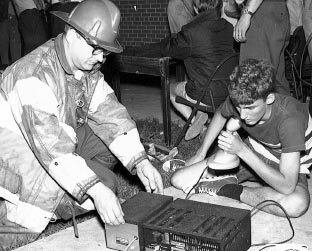
Local severe weather
expert shoulders key
responsibility in new role
By Per Peterson

Responding to a disaster in 2017 is not the same as it was 49 years ago when an EF5 tornado ripped a hole in the heart of Tracy. Emergency personnel have always had the same goal when responding to a catastrophic event, but technology has greatly changed the way they communicate with each other.
In order to coordinate a wide array of communications systems during disasters, the Department of Homeland Security and Federal Emergency Management Agency created what is known as a Communications Unit Leader. That person is charged with making sure agencies on all levels, each using different frequencies, can communicate efficiently during chaos.
There are about 40 of them in Minnesota, including Murray County resident Kevin Haney, who received his Communications Unit Lead (COML) certificate in December. He completed his extensive communications exercise in October, then had to get approved by the Southwest Emergency Communications Board and then get passed for approval by the Minnesota State Emergency Communications Board.
Haney said it’s not his job to arrive on the scene of a disaster and immediately take over. Instead, he is called in by an incident commander to foster open communication. COMLs are not the leaders during an incident, but they’re the ones who create open lines of communications among emergency responders. He assists the incident commander in coordinating the communications for all agencies that have reported to a disaster.
“If I had 20 different ambulance services, 20 different fire departments, the FBI, Secret Service, ATF — whoever shows up on scene — they’re all going to want to take control,” Haney said. “You can’t have that. That’s a disaster waiting to happen. A good example is during the 35W bridge collapse — they had a whole bunch of agencies from all over: state, federal, local, coming in for this disaster. Each one of those agencies has their own frequencies they’re used to talking on. They all have to be coordinated in a way to make it efficient for the disaster to get resolved. ”
A Communications Unit Lead is a position under the Logistics Section of the Incident Command System (ICS). As emergency responders responsible for leading radio communications during all-hazards emergency operations, all COMLs must have detailed knowledge of local communications, communications systems, local, regional, and state communications programs, according to Emergency Communications Networks, a division of Minnesota Department of Public Safety. A COML’s responsibilities include developing plans for incident communications equipment and facilities, managing the distribution of communications equipment to incident personnel, and coordinating installation and testing of equipment.
Because COML is a position under ICS, it is jointly executed by state governments and the US Department of Homeland Security (DHS) as part of the SAFECOM program. State governments administer training and certification, while DHS provides oversight and leadership.
For more on this article, see this week’s Headlight-Herald.
